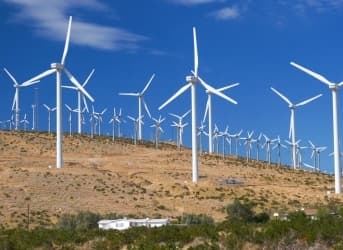In mid-December, the U.S. Interior Department announced plans to auction off more than 79,000 maritime acres off the coast of Maryland for wind energy development. Two leases in 2013 generated more than $5 million in bids from investors but the industry faces an uncertain future as the private sector takes the lead in renewable energy development.
The Interior Department's Bureau of Ocean Energy Management said the wind energy potential off the Maryland coast may be significant. More than 79,000 acres will be put on the auction block for wind energy developers next year and the BOEM estimates the area could support more than 850 megawatts of power if the region is developed fully.
Wind is a premier source of renewable energy in the United States, beating out hydroelectric power as the primary alternative resource for consumers. While renewable energy still pales in comparison to fossil fuels, wind capacity inland has increased from 1.5 gigawatts in 1992 to 45 GW by the end of 2011, providing more than 3 percent of total electricity generation.
While there are no commercial wind energy developments offshore, that's about to change. In 2013, two lease sales for acreage in the Atlantic Ocean generated $5.4 million in bids from wind energy developers. Deepwater Wind New England, which bet $3.8 million on the wind potential offshore Rhode Island and Massachusetts, said nearly 350,000 utility customers will be getting their annual energy needs met by wind by 2018.
For Maryland, state Gov. Martin O’Malley said wind energy was about more than just moving away from fossil fuels.
"The development of offshore wind will drive economic development in Maryland, create high-quality, family-supporting jobs for Maryland residents and play a major role in reducing emissions and protecting the environment," he said.
But the sector faces an uncertain future. The implementation in 1992 of a wind energy production tax credit helped provide a solid foundation under the sector. The tax credit, however, has often found itself on the chopping block of lawmakers debating future budgetary policies. The incentive barely survived last year's budget imbroglio and faces an uncertain future before it expires again by the end of this year.
Supporters of the fossil fuel industry say wind energy is a "boutique" energy resource that's expensive even with the federal government's tax credit. The wind industry, meanwhile, credits the tax incentives for a robust year, where 68.3 MW of wind power were completed during the third quarter of 2013. The latest budget deal, proposed by Rep. Paul Ryan, R-Wisc., and Sen. Patty Murray, D-Wash., left the wind tax credit on the cutting room floor. Without the federal incentive, next year's wind energy auction offshore Maryland may be the bellwether for the sector in the United States.
By. Daniel J. Graeber of Oilprice.com



















A combined cycle natural gas turbine plant studied by the DOE completed in 2010 is rated at 570 mw and produces 470 mw, capacity factor 85%. cost $311 MILLION. life cycle 35 years therefore this plant will produce 133 Terawatts life cycle.
Cape wind project in nantucket sound has been approved. the project will cost $2.6 BILLON, and it has secured funding for $2 billon of that from a japanese bank. but this is believed to be subject to the project gaining a loan guarantee from the u.s. department of energy. the contracted cost of the wind farm's energy will be 23 cents a kilowatt hour (excluding tax credits, which are unlikely to last the length of the project), which is more than 50% higher than current average electricity prices in massachusetts. the bay state is already the 4th most expensive state for electricity in the nation. even if the tax credits are preserved, $940 million of the $1.6 billion contract represents costs above projections for the likely market price of conventional power. moreover, these costs are just the initial costs they are scheduled to rise by 3.5 percent annually for 15 years. by year 15 the rate will be $.38 per Kilowatt.
This project is rated at 468 mw and will produce 143 mw after applying a capacity factor of 30.4 % the time the wind actually blows. life cycle is 20 years therefore this project will produce 24.6 Terawatts life cycle.
It would be very useful if you did not mix-up energy and power units. Power is in Watts (or kiloWatts or Terawatts, etc.). Energy is in Watt-hours (or kilowatt-hours or Terawatt-hours, etc.).
Despite this misuse of units, your conclusions are essentially correct